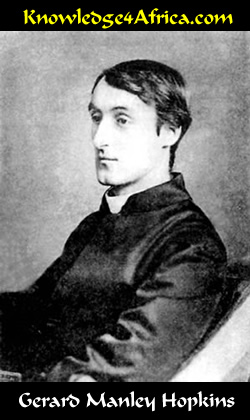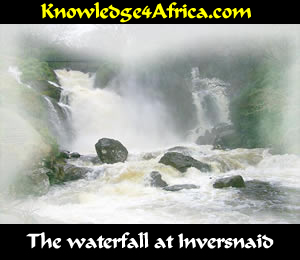|
READ THIS
"Inversnaid" is the description of a stream tumbling down through the highlands of Scotland to the
waterfall at Inversnaid.
At its heart is a hymn of praise for the beauty of creation, as well as an appeal for such wildernesses to
be left unspoilt.
 INSCAPE & INSTRESS
INSCAPE & INSTRESS
At the heart of understanding Hopkins' poetry are two fundamental principles which the poet called
inscape and instress.
Hopkins, in his search for an aesthetic understanding of nature, found value in the writings of the great
medieval theologian-philosopher, Duns Scotus, who attempted to distinguish the difference between the
individual and the species.
What makes Peter different from other men? What makes Angela different from other girls? What
makes my cat different from other cats?
Duns Scotus claimed that Peter and Angela each have an essence, a "this-ness", which is what
marks them apart from others.
My cat too has a "this-ness".
Hopkins would expand on the concept of "this-ness" and call it inscape.
Inscape then is that unique property in things which makes them distinctive. It is the inner essence
of the thing.
This uniqueness represents the beauty of the thing. Even more: it represents the beauty of God that is
reflected in the thing.
When the poet looks into the sky in the morning and sees a falcon floating on the wind, he sees more than
just a bird. He sees the inner beauty of the bird.
But within this inner beauty, he also sees the beauty that is God. The falcon's inscape is therefore
the beautifying principle of God himself.
Not everybody, however, can see this inscape, this inner manifestation of beauty and the presence
of God. Only the true artist can see it.
And Hopkins gave the name instress to this ability to witness the inscape in something.
Instress is therefore the feeling that one has for the inner quality in something. This is what
characterises the artist.
Instress is the mystical ability that enables the artist to perceive the inner beautifying
principle or inscape.
Instress is the sensation of inscape, where the artist becomes aware of the
inscape of the thing of beauty.
Most living people, Hopkins said, are fundamentally dead to this world of inscape, i.e. most people
just cannot see this inner beauty in something else.
Artistic creation, on the other hand, happens when the artist becomes instressed with the personal
inscape of the other.
The work of art that then follows -- e.g. a poem or painting -- is what Hopkins called a new
inscape.
The poem or painting thereupon has its own inscape -- i.e. it too becomes a thing of beauty which
reflects the beauty of God.
When the reader's inscape becomes aware of the beauty of the poem, then the reader has become
instressed.
But once again, not everybody has this ability. The kid in the classroom who bleats, "Ma'am, why do
we have to do poetry?" says this because he lacks instress.
He's the type of being who looks at the sunset and is reminded of a fried egg, soft side up.
Have you looked at the questions
in the right column?
|
TEST YOURSELF!
Read the left column and then answer
the following questions:
Turns and twindles over the broth
Of a pool so pitchblack.
- The word "twindles" is a creation by the poet. What do you think it means? (4)

[Need help?]
"Twindles" is possibly a mixture of three words: "twists", "twins", i.e. the stream
breaks up into two (see the picture), and "dwindles", i.e. it gets smaller.
It could also encompass the word "twitches".
By the way, a word that is created by using several other words is known as a portmanteau word.
|
- What is "the broth of a pool"? Hint: the poet is NOT comparing the pool, or its colour, to a cup
of soup! (4)

[Need help?]
A "broth of a pool" is an Irish expression which means "the very essence of a pool". It is a
perfect pool.
If an Irishman were to say that you are "a real broth of a boy" or "you're a broth of a girl", he
would be complimenting you.
Indeed, he'd be saying that you are everything that is needed to be a boy or a girl. You are a proper boy
or girl.
The poet is therefore saying that the pool is a perfect pool.
|
a pool so pitchblack, féll-frówning,
It rounds and rounds Despair to drowning.
- Why is the pool "pitch black" and "féll-frówning"? (4)

[Need help?]
Inversnaid overlooks Loch Lomond. Is the poet then referring to Loch Lomond when he speaks of "the
pool"?
He is certainly referring to a body of water that is so deep that it appears black -- pitch black.
"Féll-frówning" is another of the poet's created words.
It could mean that the hills which are overlooking the pool are causing a shadow to fall on it, as though
the hills were frowning on the pool.
|
- What does the poet mean when he says "It rounds and rounds Despair to
drowning"? (4)

[Need help?]
It has been suggested that the poet, upon looking at this deep, black pool, feels despair coming over him.
Do you think this is likely? Not at all! In fact, the opposite is more likely.
The poet, upon looking at so much beauty, feels all despair leaving him. It is the Despair that is
drowning, not the poet drowning in despair.
|
Degged with dew, dappled with dew
Are the groins of the braes that the brook treads through.
- Comment on the use of alliteration in the first line. (4)

[Need help?]
There are four words in this first line that begin with the letter "d": degged, dew, dappled, dew.
"Degged" is a Scottish word that means "sprinkled".
"Dappled" means "marked with spots or rounded patches of colour or shade".
So the poet is describing the sprinkling of the plants with dew, and the variegated colouring of the plants
caused by the droplets of dew.
The alliteration provides a very lyrical, very musical quality to the poem.
|
- Comment on the word usage in the second line. (4)

[Need help?]
"Groins" is a most interesting word, isn't it? It means two things.
It means the lower area of the abdomen, or genital area. It could therefore be a symbol of fertility and life
-- that fundamental portion of the braes that blossoms with life.
It is also an architectural term and therefore describes the remarkable architecture of the waterfall.
|
Wiry heathpacks, flitches of fern,
And the beadbonny ash that sits over the burn.
- "Flitches of fern" is the most wonderful onomatopoeia. Explain. (4)

[Need help?]
"Heathpacks" are patches of heather while "flitches" is a Scottish word for tufts of fern.
The use of "flitches" also creates the sound of scrunching as one crushes the dry fern leaves. By
doing so, the word brings a lyrical, musical quality to the line.
|
- Explain the choice of words in "beadbonny ash". (4)

[Need help?]
"Beadbonny" is a word created by Hopkins himself.
It could refer to the red buds on the Ash tree. "Bonny" is the Scottish for "pretty".
There is possibly another interpretation here too. Consider that Hopkins was a Catholic priest who would
often be praying his rosary. Now a rosary is a form of a prayer wheel which is full of beads -- 60 of them
to be precise.
So is Hopkins reminded of the rosary when he sees the beads on the Ash tree?
|
What would the world be, once bereft
Of wet and of wildness? Let them be left,
O let them be left, wildness and wet;
Long live the weeds and the wilderness yet.
- Is Hopkins suddenly giving way to a mood of depression in this verse? Explain. (4)

[Need help?]
In the first three verses of this poem, it would seem that Hopkins is absorbed with the beauty of the river
and cataract that make up the Inversnaid Falls.
Through being absorbed with its beauty, he is also absorbed in the essence of God which shines through
that beauty.
In this last verse, Hopkins sums up his praise of the wildness and the wet while at the same time he
pleads with God not to allow this beauty to disappear, possibly through the encroaching urbanisation and
industrialisation.
|
- Comment on the use of alliteration in these lines. (4)

[Need help?]
The alliteration -- repetition of the letter "w" -- creates a distinct lyrical or musical value to the
verse.
Hopkins spent many years in Wales and, while there, studied the very lyrical way of Welsh speaking. He
translates this into his poetry and uses devices like alliteration to establish the effect.
|
|





